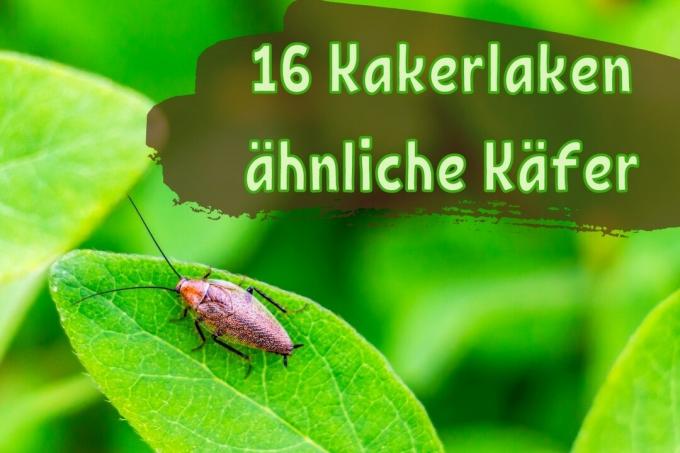
table of contents
- Characteristics of cockroaches
- Types from A - E
- Types of F - M
- Types of N - S
- Types from T - Z
- frequently asked Questions
Cockroaches is the collective name for several storage pests and similar beetles that can even transmit bacteria and various parasites to humans. Some species of beetle look very similar to cockroaches, but they are completely harmless.
In a nutshell
- there are mainly three types known as cockroaches
- Beetles that have similar characteristics are usually not storage pests
- Beetles with similar characteristics are mostly other cockroaches or bed bugs
- Similar species of beetles usually invade living spaces unintentionally
Characteristics of cockroaches
In order to actually distinguish a cockroach from similar beetles, it is important to know the three species that are dangerous storage pests.
German cockroach (Blattella germanica)
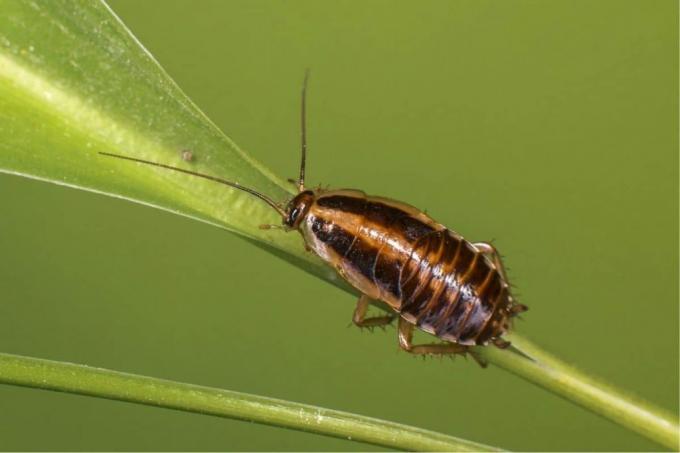
- Length: 12-15 mm
- Brown
- 2 dark vertical stripes on the chest
- Wing covers cover the entire body, sometimes even a little excess length
Oriental cockroach (Blatta orientalis)

- Length: 25-30 mm
- dark brown to black
- shortened wings
American cockroach (Periplaneta americana)

- Length 28 - 44 mm
- red-brown
- pale yellow to orange in the front of the chest
- well-trained airworthy wings
Note: All cockroaches, including those that are harmless, have similar characteristics and this includes the long, well-developed antennae.
Types from A - E
Amber wood cockroach (Ectobius vittiventris)
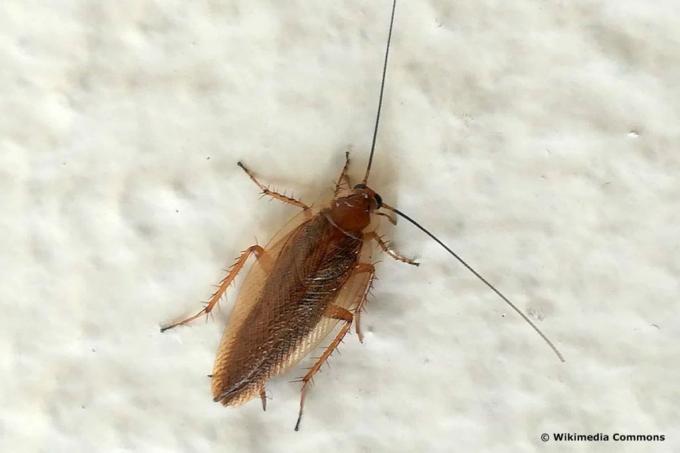
- Length: 9-14 mm
- Appearance: light brown Hall shield, pronotum transparent at the edge, wings finely dotted and translucent, distinctive body shape tapering towards the rear
- Occurrence: mainly southern Europe, since the 21. Century also proven north of the Alps
- Food: decomposed plant material
- Special features: occasional mass multiplication in warm and dry summer months, is attracted by light and penetrates into apartments
Nettle bug (Heterogaster urticae)

- Length: 6 - 7 mm
- Appearance: black-gray basic color, with whitish and reddish-brown spots, legs hairy
- Occurrence: biotopes with nettles
- Food: sap of nettles
- Special features: larvae feed exclusively on the juice of the nettle seeds
Oak bug (Harpocera thoracica)

- Length: 6 - 6.8 mm
- Appearance: dark brown to black basic color, brownish pronotum, black triangular spot on the pronotum, black and white spots on wing tips
- Occurrence: sunny and dry meadows
- Diet: male buds with pollen, aphids
- Special features: rapid development from the young stage to the adult beetle in just 2 weeks
Eremocoris fenestratus
- Length: 6 - 6.6 mm
- Appearance: red-brown to black basic color, thickened fore legs
- Occurrence: sunny and warm areas with cypress plants
- Food: sap from the seeds of the cypress family
- Special features: very seldom to be found, as it is tied to its food plants
Types of F - M
Spruce cone bug (Gastrodes abietum)
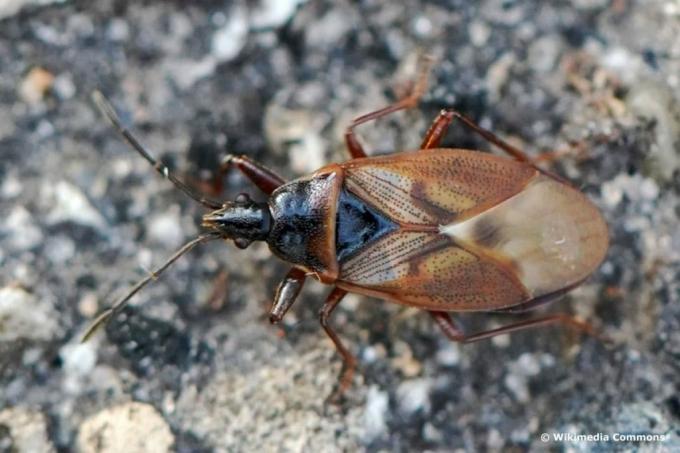
- Length: 7 - 7.5 mm
- Appearance: brown basic color, pronotum black followed by a black triangle, fore thighs thickened
- Occurrence: spruce
- Food: sap from the seeds of spruce trees
- Special features: has a very flattened body, which makes it easy for them to get into the seeds
Shiny soft bug (Deraeocoris lutescens)

- Length: 3.7 - 4.5 mm
- Appearance: orange-brown basic color, black pattern, two dark spots on the neck plate
- Occurrence: deciduous trees
- Food: live predatory and feed mainly on aphids or leaf fleas
- Special features: beneficial insects in the garden
Lapland wood cockroach (Ectobius lapponicus)

- Length: 9-12 mm
- Appearance: Males can fly, females with shortened wings, dark spot on pronotum, black spots on the wings
- Occurrence: mainly in forests with a layer of shrubbery
- Food: decomposed plant material
- Special features: occasionally get lost indoors
Lepidargyrus ancorifer
- Length: 3 - 4 mm
- Appearance: black-brown basic color, lightly haired
- Occurrence: orchards, ruderal areas, meadows
- Food: vegetable juices
- Special features: mainly to be found in climatically favorable regions
Types of N - S
Nut-colored pore long bug (Cymus glandicolor)
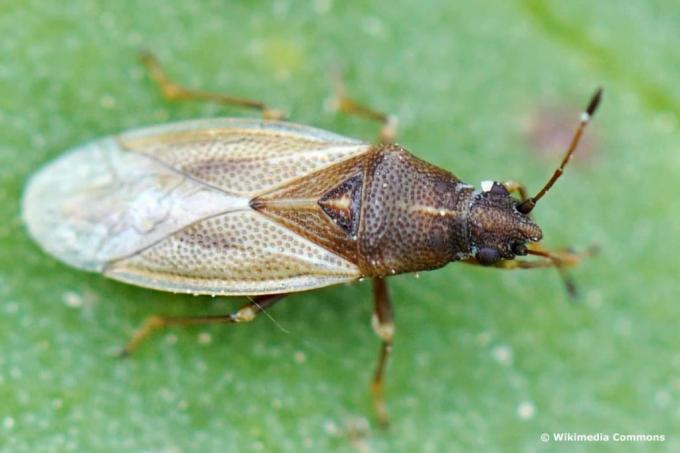
- Length: 3.7 - 5 mm
- Appearance: elytra light brown, pronotum dark brown
- Occurrence: wet meadows, in winter in the leaves along forests
- Food: sap from seeds and sedges
- Special features: can also be found in the garden with a pond
Note: Has similar characteristics to the young German cockroach. However, it is clearly differentiated by the shorter antennae, which are thickened at the end.
Phytocoris tiliae

- Length: 6 - 7 mm
- Appearance: speckled gray-green to black, noticeably long hind legs
- Occurrence: Trees in Allen, parks, bushes, deciduous forests
- Food: plant saps, smaller insects
- Special features: mostly hides in lichens
Sycamore bug (Arocatus longiceps)

 gmx.at. German: source and reference to kulac
gmx.at. German: source and reference to kulac gmx.at requested., Arocatus longiceps 02, edited by Plantopedia, CC BY-SA 3.0
gmx.at requested., Arocatus longiceps 02, edited by Plantopedia, CC BY-SA 3.0- Length: 5.5 - 6.6 mm
- Appearance: red-brown basic color, pronotum with black spots, wings with three black triangles, hairy
- Occurrence: plane trees, occasionally linden, maple or chestnut
- Diet: sap from the seeds of the preferred trees
- Special features: originally from Asia or Immigrated to southern Europe
Black ground bug (Drymus ryeii)

- Length: 3.5 - 4.6 mm
- Appearance: entire body in black basic color with isolated dark brown areas
- Occurrence: forests
- Food: sap from moss
- Special features: overwinter in loose bark, which means that they like to come into apartments with bark deco material
Types from T - Z
Tangier wood cockroach (Planuncus tingitanus)

- Length: variable depending on the subspecies
- Appearance: pale yellow to brownish basic color, shortened wings, yellowish central spot with darkened edge
- Occurrence: shrubs in settlement areas, inner-city small forests
- Food: decomposed plant material
- Special features: originally located in more southerly regions, spread favored by road traffic, are attracted by light
Tappert (Beosus maritimus)

- Length: 6 - 7.5 mm
- Appearance: black-brown basic color with whitish spots
- Occurrence: sandy soils, loamy fallow land, grasslands, heaths
- Food: juices from plant seeds such as meadow hogweed
- Special features: only trains one generation per year
Inconsistent Narrowhans (Dicyphus errans)

- Length: 4.5 - 5.1 mm
- Appearance: black first and second wing parts, Hall shield predominantly black, dark gray to brownish wing covers
- Occurrence: prefers open habitats with a low herbaceous layer, also found in gardens or greenhouses
- Food: sap from various plants such as cranesbills, ragweeds, sage; They also suckle on various insects such as spider mites, aphids or dead animals
- Special features: adult animals overwinter under the rosettes of plants such as mullein and are active until late in winter
Forest ground bug (Drymus sylvaticus)

- Length: 3.5 - 4.6 mm
- Appearance: black, matt body color, brownish on the abdomen
- Occurrence: semi-arid and poor grassland
- Food: sap from plants in their natural habitats
- Special features: naming is rather misleading, as this species does not live in forests
frequently asked Questions
If you are not sure which beetle it is, carefully catch the insect and place it in a jar with a sheet of paper over it. This makes it easier to identify the insect and view it from all sides.
Avoid unnecessary light sources around the house and in the garden. This not only attracts bugs that have characteristics similar to cockroaches, but generally various insects that also invade the house.
If it is not a cockroach, the beetle should be taken outside immediately. In winter it is advisable to leave them in protected areas such as under evergreen shrubs and trees.
Beetles have similar characteristics, especially with cockroaches in the young stage. Later on, similar beetles can usually be distinguished from the pests by their size alone.


